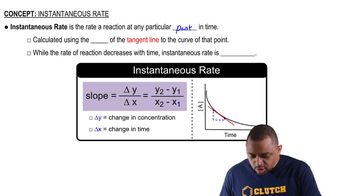Here are the essential concepts you must grasp in order to answer the question correctly.
Reaction Rate
The reaction rate refers to the speed at which reactants are converted into products in a chemical reaction. It can be expressed as the change in concentration of a reactant or product over time. Understanding how to calculate reaction rates is essential for analyzing chemical kinetics and determining how quickly a reaction proceeds.
Recommended video:
Instantaneous Rate
The instantaneous rate of a reaction is the rate at a specific moment in time, rather than over an interval. It can be determined by taking the slope of the tangent line to the concentration vs. time graph at the desired time point. This concept is crucial for accurately assessing how fast a product is being formed or a reactant is being consumed at any given moment.
Recommended video:
Stoichiometry
Stoichiometry involves the quantitative relationships between the reactants and products in a chemical reaction, based on the balanced chemical equation. In the given reaction, the stoichiometric coefficients indicate that for every 2 moles of H2O2 decomposed, 1 mole of O2 is produced. This relationship is vital for converting the rate of formation of one substance into the rate of formation of another.
Recommended video:




